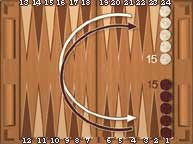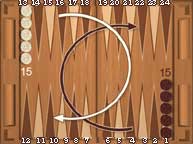Description
Tavli is a game consisting of three (3) other individual games.
One of them is the well known backgammon
(BG) with the exception of the doubling and usually the backgammon rule
(3 points win). The same applies to all three games. It is played to
five (5) or seven (7) points or, rarely, three (3) points.
The equivalent of BG is the game called Portes.
The other two are Plakoto and Fevga. The exact equivalent of BG is
Vidos.
The object of all three games—like BG—is to move all your
checkers in the designated quarter of the board (home area) and collect
them. BG has the most difficult setting of the checkers on the
board at the starting point.
Plakoto
You put all the checkers at point 1 and 24 equivalently, as shown
below.

As with BG if two or more pieces are in one position they form
a barrier, porta. However when there is only one checker in a
position it can be frizzed by a checker of the opponent. That means,
if a white checker say, can be placed on top of a single black checker
then until it is removed the black checker can not be removed.
Note 1: More than one white checkers, in the example above, can be placed on top as well.
Note 2: The starting positions (1 and 24) are the master positions,
"mana". If a single, (the last obviously) checker—the master checker—is
caught there by the opponent the game is won as a backgammon.
Fevga
That's maybe the most difficult one to explain and to play well. The
checkers are set in two opposite corners. It's a game of speed and
positioning. Both players play in the same direction, let's say counter
clockwise. The two setting corners are for instance positions 13 and 1
as in the figure below.

The first thing to do is to place a single
checker in the opponent's starting quarter. Each player can only move
that checker until then. Once you do that you may start moving the
other 14 checkers. A single checker here blocks a position.
Note 1: A player can not at any point block all six positions of its starting quarter.
Note 2: When one of the players has formed a six position barrier and
the other player has collected all of his/hers checkers at the single
position behind the barrier then the first player has to create a
playable position for the second player.
Note 3: A variation of Fevga is Giul. The only difference to Fevga is
that when you roll a double you have to play that double and all the
others in an increasing manner, e.g. if you roll 4x4 then you have to
play 4x4, 5x5 and 6x6.
Meaning of Greek names
The name of the three games in Greek have their meaning. Portes means
"doors". Two checkers together form a "door", a wall if you like, where
the opponent can not place his/hers checkers.
Plakoto comes from the
greek verb "plakono" which means to put something on top of something
else (in the game to put a checker on top of an opponent's checker).
Fevga means "to run", and in the game reflects a fast and well
positioned play in order to get to your home quarter.
| 


![]()
